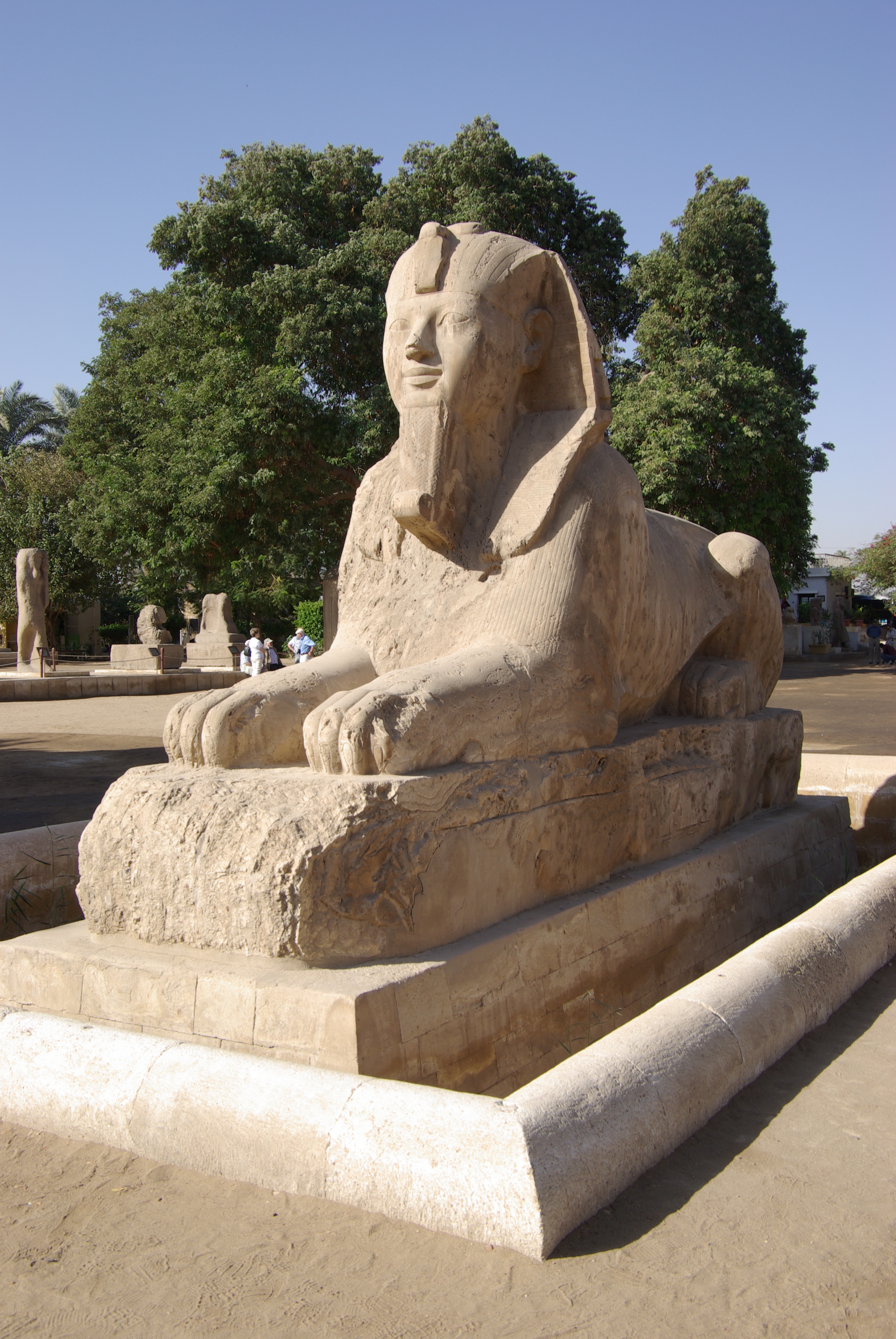Sphinx Of Memphis on:
[Wikipedia]
[Google]
[Amazon]
 The Sphinx of Memphis is a stone
The Sphinx of Memphis is a stone
 The Sphinx of Memphis is a stone
The Sphinx of Memphis is a stone sphinx
A sphinx ( , grc, σφίγξ , Boeotian: , plural sphinxes or sphinges) is a mythical creature with the head of a human, the body of a lion, and the wings of a falcon.
In Greek tradition, the sphinx has the head of a woman, the haunches o ...
located near the remains of Memphis, Egypt
, alternate_name =
, image =
, alt =
, caption = Ruins of the pillared hall of Ramesses IIat Mit Rahina
, map_type = Egypt#Africa
, map_alt =
, map_size =
, relief =
, coordinates = ...
. The carving was believed to take place between 1700 and 1400 BCE, which was during the 18th Dynasty. It is unknown which pharaoh is being honored and there are no inscriptions to supply information. The facial features imply that the Sphinx is honoring Hatshepsut
Hatshepsut (; also Hatchepsut; Egyptian: '' ḥꜣt- špswt'' "Foremost of Noble Ladies"; or Hatasu c. 1507–1458 BC) was the fifth pharaoh of the Eighteenth Dynasty of Egypt. She was the second historically confirmed female pharaoh, af ...
, or Amenhotep II
Amenhotep II (sometimes called ''Amenophis II'' and meaning ''Amun is Satisfied'') was the seventh pharaoh of the Eighteenth Dynasty of Egypt. Amenhotep inherited a vast kingdom from his father Thutmose III, and held it by means of a few milita ...
, or Amenhotep III.
Discovery
The Alabaster Sphinx was discovered in 1912, when an affiliate from the British School in America spotted a uniquely carved object jutting out of a sand hill. It was so far in the season that excavation was useless, but a year later in 1913 further digging displayed that the object was a Sphinx's tail.Composition
The Sphinx of Memphis is also referred to as theAlabaster
Alabaster is a mineral or rock that is soft, often used for carving, and is processed for plaster powder. Archaeologists and the stone processing industry use the word differently from geologists. The former use it in a wider sense that includes ...
Sphinx of Memphis, or the Calcite
Calcite is a carbonate mineral and the most stable polymorph of calcium carbonate (CaCO3). It is a very common mineral, particularly as a component of limestone. Calcite defines hardness 3 on the Mohs scale of mineral hardness, based on scra ...
Sphinx. It is the largest calcite statue ever discovered.
The minerals alabaster
Alabaster is a mineral or rock that is soft, often used for carving, and is processed for plaster powder. Archaeologists and the stone processing industry use the word differently from geologists. The former use it in a wider sense that includes ...
or calcite
Calcite is a carbonate mineral and the most stable polymorph of calcium carbonate (CaCO3). It is a very common mineral, particularly as a component of limestone. Calcite defines hardness 3 on the Mohs scale of mineral hardness, based on scra ...
in the sphinx's names refer to the yellowish white, soft stone it is carved from; archaeologists and stonemasons have different criteria from mineralogists for distinguishing the very similar minerals calcite and alabaster. Calcite is a simple and common material that has been mined from the earth for centuries. This natural stone was considered beautiful, and in ancient Egypt was believed to have a mystical connection to the Sun.
Physical attributes
With a length of 8 m (26 ft) and a height of 4 m (13 ft), the Sphinx of Memphis is considerably smaller than the more recognizedGreat Sphinx of Giza
The Great Sphinx of Giza is a limestone statue of a reclining sphinx, a mythical creature with the head of a human, and the body of a lion. Facing directly from west to east, it stands on the Giza Plateau on the west bank of the Nile in Giz ...
. At those dimensions, it is estimated to weigh around 90 tons. It is supported by a foundation that makes it appear to rise out of the sand. Particularly unusual about the Sphinx of Memphis are the striations on its left side, which are uncommon on Egyptian monuments.
Other information
As years passed from the sphinx's creation, people ravaged Memphite temples and the Sphinx of Memphis is one of the few masterpieces that survived this pillaging. During its time this statue was also displayed near a temple in honor ofPtah
Ptah ( egy, ptḥ, reconstructed ; grc, Φθά; cop, ⲡⲧⲁϩ; Phoenician: 𐤐𐤕𐤇, romanized: ptḥ) is an ancient Egyptian deity, a creator god and patron deity of craftsmen and architects. In the triad of Memphis, he is the ...
. Ptah was one of the Egyptians' world-creator gods.
References
{{reflist, 25em 2nd-millennium BC sculptures Sculptures of ancient Egypt Eighteenth Dynasty of Egypt Alabaster Sphinxes